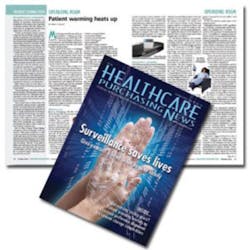We applaud you for raising awareness for the importance of keeping patients warm (normothermic) before, during and after surgical procedures. However, as a company committed to science and patient safety we’d like to address several factual errors and misstatements made by a competitor in the article.
First, contrary to competitors’ claims, there is absolutely no credible evidence that the 3M Bair Hugger warming system increases the risk of surgical site infections. Since 1987, more than 200 million patients worldwide have been warmed using the Bair Hugger system. In its entire history, there has not been a single confirmed case of infection caused by the Bair Hugger system. Moreover, there is substantial evidence that the use of Bair Hugger therapy to establish and maintain intraoperative normothermia is associated with decreased adverse consequences, including surgical infections.
Second, the notion that heated air from the Bair Hugger system disrupts conventional or laminar air flow in the operating room and increases the risk of surgical infections is purely speculative; several independent studies have shown that air from the Bair Hugger system does not increase the risk for surgical wound contamination from particulates. In fact, a 1997 study by Avidan, et al, concluded that a blanket properly attached to the warming unit did not disperse contaminated particles from the blanket.
Using computational fluid dynamics (CFD) and particle tracking methodology, the National Institutes of Health (NIH) assessed whether forced-air patient warming systems increase the risk of nosocomial infections at the surgical site. The NIH looked at both “heat-generating factors and ventilation factors” and concluded: “there is zero percent deposition on the patient for the contaminant sources.” NIH also concluded that “forced-air warmers seem to cause minimal disruption to laminar airflow systems.” (Memarzadeh F., Active Warming Systems to Maintain Normothermia in Hip Replacement Surgery, J. Hosp. Infect., at 1 (2010) (letter to the editor.) Ultimately, the NIH found that “[t]his investigation validates Moretti et al.’s conclusion that forced-air warming technology does not increase the risk of surgical wound infection.”
Third, the reference to CDC guidelines is about heating/cooling systems — not patient warming systems — and is therefore completely out of context.
Let me be clear, the Bair Hugger system’s clinical benefits, efficacy and safety have been well documented in more than 170 studies — far more than any other patient warming modality. Published research papers have shown that the use of Bair Hugger therapy does not increase either the risk of wound contamination in the operating room or bacterial contamination of operating rooms. (Sessler DI, Olmsted RN, Kuelpmann R. Forced-air warming does not worsen air quality in laminar flow operating rooms. Anesth Analg. 2011;113(6):1416-1421. Moretti B, Larocca AM, Napoli C, Martinelli D, Paolillo L, Cassano M, Notarnicola A, Moretti L, Pesce V. Active warming systems to maintain perioperative normothermia in hip replacement surgery: a therapeutic aid or a vector of infection? J. Hosp. Infect. 2009;73(1):58-63.)
Far from increasing risk, the use of Bair Hugger therapy notably reduces risk of several serious postsurgical adverse consequences including bleeding, infections, cardiac events, and thermal discomfort.
An independent, systematic review of the published literature by ECRI — a non-profit organization recognized by The New York Times as “the country’s most-respected laboratory for testing medical products” — found “[b]ased on our focused systematic review of the published literature, we believe that there is insufficient evidence to establish that the use of FAW systems leads to an increase in SSIs compared to other warming methods.” (ECRI, Forced-air warming and surgical site infections. Health Devices, 2013 (April): p. 122-125.)
According to the Duke Infection Control Outreach Network, November 2015, “To the best of our knowledge, no adequately powered, properly controlled, statistically significant, reproducible study has been published that demonstrates an increased risk of surgical site infections due to the use of forced-air warming (FAW) devices … We believe that it is reasonable and appropriate to continue to use FAW warming devices … Indeed, our data and that collected by the NHSN suggest that approximately 99 percent of patients undergoing joint replacement procedures do not develop a surgical site infection despite the fact that FAW warming devices continue to be widely and appropriately used … they are the only devices proven to decrease the risk of developing a post-operative infection.”
There is absolutely no evidence that Bair Hugger warming therapy causes or increases the risk of surgical site infections. In fact, patient warming is recommended by leading health care institutions and professional societies — and the Bair Hugger system is a safe, effective and efficient method of doing so.
Thank you for the opportunity to share these important facts about this critically important therapy.
Sincerely,
Al Van Duren
Science and Education Manager
3M Infection Prevention Division
Visit: www.hpnonline.com/patient-warming-heats/ to read the orginal article.


